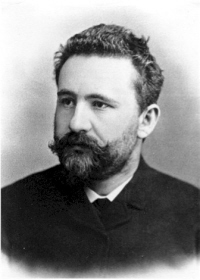
Emil Kraepelin (February 15, 1856- October 7, 1926) was a German Psychiatrist who attempted to create a synthesis of the hundreds of mental disorders classified by the 19th century, grouping diseases together based on classification of common patterns of symptoms, rather than by simple similarity of major symptoms in the manner of his predecessors. In fact, it was precisely because of the demonstrated inadequacy of such methods that Kraepelin developed his new diagnostic system.
In 1886, after only eight years of training, he was appointed to a professorship at the University of Tartu (then Dorpat) in what is today Estonia and became the director of an eighty-bed University Clinic. There he was able to study and record many clinical histories in detail and "was led to consider the importance of the course of the illness with regard to the classification of mental disorders." Ten years later he announced that he had found a new way of looking at mental illness. He referred to the traditional view as "symptomatic" and to his view as "clinical."
Drawing on his long term research, and using the criteria of course, outcome and prognosis, he developed the concept of dementia praecox, which he defined as the "sub-acute development of a peculiar simple condition of mental weakness occurring at a youthful age." When he first introduced this concept as diagnostic entity in the fourth German edition of his Lehrbuch der Psychiatrie in 1893, it was placed among the degenerative disorders alongside, but separate from, katonia and dementia paranoides. At that time the concept corresponded by and large with Ewald Hecker's hebephrenia. In the sixth edition of the Lehrbuch in 1899 all three of these clinical types are treated but as different expressions of one disease, dementia praecox.
Kraepelin postulated that there is a specific brain or other biological pathology underlying each of the major psychiatric disorders. Just as his laboratory discovered the pathologic basis of what is now known as Alzheimers disease, Kraepelin was confident that it would someday be possible to identify the pathologic basis of each of the major psychiatric disorders.
One of the cardinal principles of his method was the recognition that any given symptom may appear in virtually any one of these disorders; i.e. there is virtually no single symptom occurring in dementia praecox (the name was later changed to "schizophrenia" by Eugen Bleuler), which cannot sometimes be found in manic-depression. What distinguishes each disease symptomatically (as opposed to the underlying pathology) is not any particular (pathognomonic) symptom or symptoms, but a specific pattern of symptoms. In the absence of a direct physiological or genetic test or marker for each disease, it is only possible to distinguish them by their specific pattern of symptoms. Thus, Kraepelin's system is a method for pattern recognition, not grouping by common symptoms.




